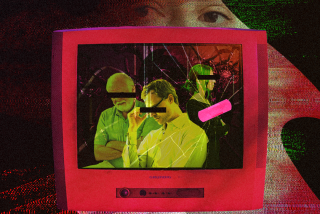It’s No Coincidence That PG-13 Has Become a Rating of Choice
- Share via
NEW YORK — As part of its recent “Sappho-rama” series, Manhattan’s Film Forum screened “The Killing of Sister George,” a 1968 lesbian-themed drama by Robert Aldrich. The houselights dimmed, the projector kicked in, and there it was, a blast from the past: “Rated X by the Motion Picture Assn. of America.”
“Maybe it was the idea of having an X rating on a serious film--the only other one I can think of is ‘Midnight Cowboy.’ Or maybe it was just because no one had seen it in such a long time,” says Bruce Goldstein, Film Forum’s repertory programmer. “But the audience gasped.”
Since 1968, the MPAA’s rating system has provided reason to rant and rave, but here’s another reason to gasp.
Last year at this time--in the wake of the April 1999 Columbine massacre--it was announced by President Clinton and the National Assn. of Theater Owners that children under 17 (and without a parent) really wouldn’t be admitted to movies rated R, a designation that previously meant little else besides “hipper than PG-13.” Photo ID would be required. A toothless rule suddenly had bite.
What happened? Take a look at the movies that have been released just this spring and summer:
* “M:I-2”? PG-13.
* “Gone in 60 Seconds”? PG-13.
* “Big Momma’s House”? PG-13.
* “Boys and Girls”? PG-13.
* “Shanghai Noon”? PG-13.
* “The Skulls”? PG-13.
* “Small Time Crooks”? PG-13.
* “U-571”? PG-13.
The list doesn’t go on and on exactly, but when you consider the movies above--adult-oriented films, for the most part, which nonetheless live and die by their teenage audiences--you see a trend.
Being a person who goes to a lot of movies, but not necessarily a lot of theaters, I asked a certain 14-year-old of my intimate acquaintance whether there weren’t a lot more PG-13 movies now than there used to be.
“Duuuuuh,” she said. It was Father’s Day. “That’s because you can’t get in anymore.”
Meaning: into theaters showing R-rated movies. Once upon a time, an R rating meant both cachet and cash. What self-respecting teenager would go to a PG or PG-13 movie--which meant, as it was supposed to, “for kids”--when one could trip blithely into an R-rated film and hear people saying the f-word and dropping their drawers? What theater owner, seeing these potential pockets to be picked and dancing along a profit margin as unstable as an Internet stock option, could justify playing parent to kids who probably already had their own?
*
What needed to change was the movies. And apparently they have.
“Since Columbine,” says a member of the MPAA’s appeals board who needs to remain anonymous, “there’s been a conscious effort to make movies more PG-13. There are easy enough ways to do it. A lot of times it just means taking . . . [an f-word] out here or there. Even someone like Martin Lawrence, whose language occasionally has been loaded with f-words, made sure to keep both ‘Blue Streak’ and ‘Big Momma’s House’ PG-13.”
The formula is pretty easy: One f-word in a nonsexual situation means a PG-13; one f-word in a sexual context means R; two in either context means R. Violence, well, it’s a tougher call.
“We really wanted to get a PG-13 for ‘The Patriot,’ but there was no way,” a Sony executive, who also wants to remain anonymous, says in acknowledging the new box-office equation. In “The Patriot,” rated R, Mel Gibson’s character is spurred to revolutionary action by the murder of his son. “The ratings board is very sensitive to any connection between violence and children, and here it’s intrinsic to the story. Take it out, and the whole movie falls apart.”
Likewise, movies such as “Me, Myself & Irene” or “Road Trip” couldn’t possibly be PG-13’ed: Vulgarity is their reason to exist. What’s remarkable, however, is how easy it’s been to tone down a lot of other films. “Boys and Girls,” although a totally useless movie, wouldn’t have gained anything by more vulgar language. Likewise “Gone in 60 Seconds,” the movie we have to vote Most Likely to Have Been an R in Another Lifetime. The language and the gratuitous sex aren’t there, but neither are they missed.
There hasn’t been an X rating since 1990 (when “Henry & June” was released that year, it was rated with the newly created NC-17). The PG-13 designation (after the release of “Indiana Jones and the Temple of Doom” in 1984) was supposed to “bridge the gap,” as the MPAA member says, between real adult movies and real children’s fare. It reminds me of my favorite sign, posted on the glass on a certain movie-house box office: “No children under 5 admitted to R-rated movies after 6 p.m.”
Five-year-olds could always get into R-rated movies, as long as they had a parent with them. But that, of course, has never really been the issue.
More to Read
Only good movies
Get the Indie Focus newsletter, Mark Olsen's weekly guide to the world of cinema.
You may occasionally receive promotional content from the Los Angeles Times.









